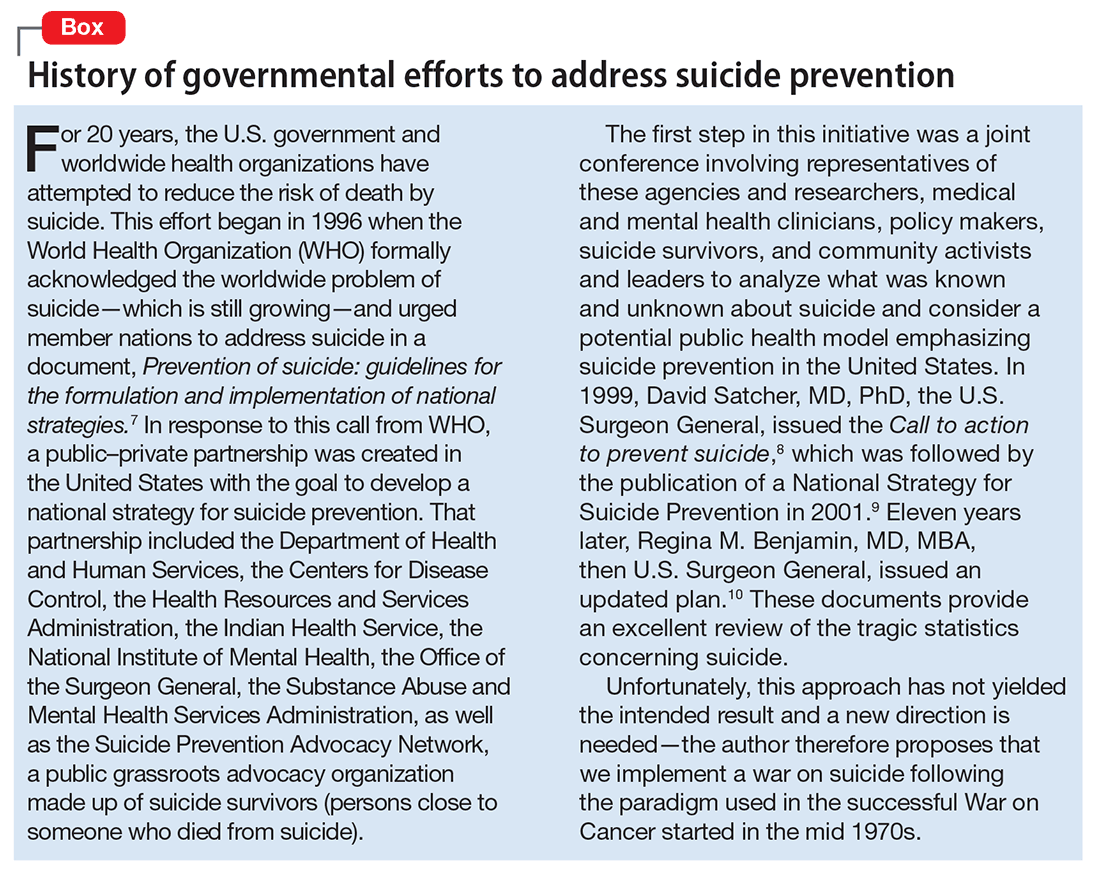Roadblocks to progress. In the absence of this proposed NSD, progress in this area has been stymied despite concerted governmental efforts (Box7-10). One reason for the lack of progress has been that governmental efforts have focused on a public health model rather than also including a basic science model aimed at exploring the biological mechanisms underlying the risk of death from suicide. In the current decentralized system, individual researchers and even teams of researchers cannot easily collect data from a sufficiently large population of suicide victims to make inroads in gaining the needed understanding.
Because of the relatively small samples that individual research teams can collect in a reasonable period of time (ie, in terms of grant cycles), many investigators have studied suicide attempts as a surrogate for suicide itself, undoubtedly because suicide attempts are more numerous than suicides themselves, making it easier to collect data. However, there is evidence that these 2 populations—suicide attempters vs those who die by suicide—only partially overlap.
First, the frequency of suicide attempts is 10 to 20 times higher than actual suicides. Second, suicide attempters are 3 times more likely to be female whereas those who die by suicide are 4 times more likely to be male. Third, most individuals who die by suicide do so on their first or second attempt, whereas individuals who have made ≥4 attempts have an increased risk of future attempts rather than for completed suicide compared with the general population. Fourth, certain psychiatric illnesses are more often associated with death by suicide (particularly major depressive disorder, bipolar disorder, and schizophrenia in the first 5 years of an illness) whereas multiple suicide attempts are more often associated with other psychiatric diagnoses such as antisocial and borderline personality disorders.
Finally, in a study in men with a psychiatric disorder, Niculescu et al5 started with 412 candidate genes and found that 208 were associated with suicidal ideation but not suicide itself, whereas 76 genes were associated with both suicidal ideation and completion. Taken together, this evidence suggests that findings concerning suicide attempters, especially those who have made multiple (ie, >3) attempts, might not be extrapolatable to the population of actual suicides.
Is there evidence that this proposal could work?
Yes, research supports the potential utility of the proposed NSD, and this section highlights some of the major findings from these studies, although this review is not intended to be exhaustive.
First, considerable evidence exists for a biological basis for the risk of death due to suicide. The concordance rates for suicide are 10 times higher in monozygotic (“identical”) vs dizygotic (“fraternal”) twins (24.1% vs 2.8%) and 2 to 5 times higher in relatives of those who die by suicide than in the general population. Heritability estimates of fatal suicides and nonfatal suicide attempts in biological relatives of adoptees who die from suicide range from 17% to 45%.11
Second, studies using information from small samples that was arduously collected by individual research groups have yielded important positive data. Most recently, in 2015, a multidisciplinary group led by Niculescu et al5 at Indiana University and other institutions described a test that could predict suicidality in men. This test was developed on the basis of a within-participant discovery approach to identify genes that change in expression between states of no suicidal ideation and high suicidal ideation, which was combined with clinical information assessed by 2 scales, the Convergent Functional Information for Suicidality and the Simplified Affective State Scale. Gene expression was measured in whole blood collected postmortem unless the method of suicide involved a medication overdose that could affect gene expression. These researchers identified 76 genes that likely were involved in suicidal ideation and suicide.
This report had a number of limitations.5 All of the individuals in these studies were being treated for psychiatric illness, were being closely followed by the investigators, and all were male. In addition, as noted above, suicides by overdose were eliminated from the analysis.
In a subsequent study published in 2016, the Niculescu group6 extended their work to women and identified 50 genes contributing to suicide risk in women. Underscoring the need for larger samples, only 3 of the top contributing genes were seen in both men and women, suggesting that there are likely significant sex differences in the biology of suicide completion. This important work needs to be replicated and extended.
In addition to these remarkable advances made in genetic understanding of the risk of suicide, recent research also has demonstrated a role for epigenetic and inflammatory processes as contributors to suicide risk.12-15
There are likely many contributors, including genetic, epigenetic, and environmental factors such as inflammatory processes, that increase the risk of suicide. The goal of this article is not to provide an exhaustive or integrative review of research in this area but rather to argue for the establishment of a national initiative to study all of these factors and to begin that process by establishing the NSD.


